These Sample papers are part of CBSE Sample Papers for Class 12 Biology. Here we have given CBSE Sample Papers for Class 12 Biology Paper 4.
CBSE Sample Papers for Class 12 Biology Paper 4
| Board | CBSE |
| Class | XII |
| Subject | Biology |
| Sample Paper Set | Paper 4 |
| Category | CBSE Sample Papers |
Students who are going to appear for CBSE Class 12 Examinations are advised to practice the CBSE sample papers given here which is designed as per the latest Syllabus and marking scheme as prescribed by the CBSE is given here. Paper 4 of Solved CBSE Sample Paper for Class 12 Biology is given below with free PDF download solutions.
Time Allowed: 3 hours
Maximum Marks: 80
General Instructions:
- There are total 26 questions and five sections in the question paper. All questions are compulsory.
- Section A contains question number 1 to 5, Very Short Answer Type Questions of one mark each.
- Section B contains question number 6 to 10, Short Answer Type Questions of two marks each.
- Section C contains question number 11 to 22, Short Answer Type Questions of three marks each.
- Section D contains question number 23, Value Based Question of four mark.
- Section E contains question number 24 to 26, Long Answer Type Questions of five marks each.
- There is no overall choice in the question paper, however, an internal choice is provided in one question of two marks, one question of three marks and all three questions of five marks. An examiner is to attempt any one of the question out of the two given in the question paper with the same question number.
- No. of printed pages are three.
SECTION-A
Question 1.
What are cleistogamous flowers?
Question 2.
What is coleorrhiza?
Question 3.
What are alleles?
Question 4.
What are introns?
Question 5.
What is apiculture?
SECTION-B
Question 6.
Explain MOET.
Question 7.
Write a note on discovery of penicillin.
Question 8.
What does the diagram below signify?
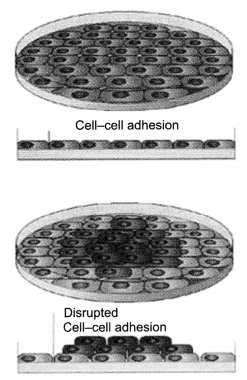
Question 9.
What are the basic steps involved in genetically modifying an organism?
OR
What is humus?
Question 10.
Represent the age pyramids for human population.
SECTION-C
Question 11.
Explain the parts of an ovule with a diagram
Question 12.
How is RNA synthesized in bacteria? Illustrate
Question 13.
Discuss the barrier methods for contraception
Question 14.
Explain convergent evolution with examples.
Question 15.
What are the major causes of cancer?
Question 16.
Is it possible to obtain large quantities of DNA from a single cell?
Question 17.
What are the advantages of GM plants?
Question 18.
Explain Ti plasmid of Agrobacterium tumefaciens.
Question 19.
Give the equations of both exponential and logistic growth curves. Also represent them graphically.
OR
Present a case study for remedy of plastic waste
Question 20.
Complete the diagram below:

Question 21.
Haploid content of human DNA is 3.3 x 109 bp and the distance between two consecutive
bp is 0.34 x 10 9. What is the length of the DNA molecule?
Question 22.
Label the diagram given below:

SECTION-D
Question 23.
Rita and her parents were watching a TV serial in the evening. During a commercial break
an advertisement flashed on the screen which was promoting use of sanitary napkins. Rita
was still watching the TV when the parents got embarrassed and changed the channel. Rita
objected to her parent’s behaviour and explained the need for these advertisements.
(a) What values did the parents show?
(b) Briefly describe the phases of a menstrual cycle.
SECTION-E
Question 24.
What are the post pollination events?
OR
Explain endosperm development.
Question 25.
What are chromosomal disorders?
OR
List the observations of Human Genome Project.
Question 26.
Explain some interspecific relationship where no species is harmed.
OR
Explain ecological succession.
Answers
SECTION-A
Answer 1.
Self pollinating flowers in which stamens and pistil are in close proximity.
Answer 2.
In embryos of monocots the root cap and radicle are enclosed in an undifferentiated sheath j called coleorhiza.
Answer 3.
Genes which code for a pair of contrasting traits.
Answer 4.
Intervening sequences in DNA which are not expressed in mature or processed RNA.
Answer 5.
Apiculture is the maintenance of hives of honeybees for the production of honey.
SECTION-B
Answer 6.
Multiple Ovulation Embryo Transfer Technology (MOET) is a programme for herd improvement. In this method, a cow is administered hormones, with FSH-like activity, to induce follicular maturation and super ovulation – instead of one egg, which they normally yield per cycle, they produce 6-8 eggs. The animal is either mated with an elite bull or artificially inseminated. The fertilised eggs at 8-32 cells stages, are recovered non-surgically and transferred to surrogate mothers. The genetic mother is available for another round of super ovulation.
Answer 7.
Alexander Fleming while working on Staphylococci bacteria, once observed a mould growing in one of his unwashed culture plates around which Staphylococci could not grow. He found out that it was due to a chemical produced by the mould and he named it Penicillin after the mould Penicillium notatum.
Answer 8.
The first diagram is that of the normal cells which show controlled growth due to property of contact inhibition.
The second diagram shows loss of contact inhibition by cancer cells. This uncontrolled cell growth leads to tumor
Answer 9.
Three basic steps in genetically modifying an organism are:
- Identification of DNA with desirable genes;
- Introduction of the identified DNA into the host;
- Maintenance of introduced DNA in the host and transfer of the DNA to its progeny.
OR
Humus is a dark coloured amorphous substance which is highly resistant to microbial action and undergoes decomposition at an extremely slow rate. Being colloidal in nature it serves as a reservoir of nutrients. The process of humus formation is called humification.
Answer 10.

SECTION-C
Answer 11.
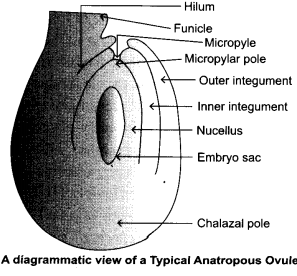
The ovule is a small structure attached to the placenta by means of a stalk called funicle.The body of the ovule fuses with funicle in the region called hilum. Each ovule has one or two protective envelopes called integuments. Integuments encircle the ovule except at the tip where a small opening called the micropyle is organised. Opposite the micropylar end, is the chalaza, representing the basal part of the ovule. Enclosed within the integuments is a mass of cells called the nucellus. Cells of the nucellus have abundant reserve food materials. Located in the embryo sac or female gametophyte.
Answer 12.
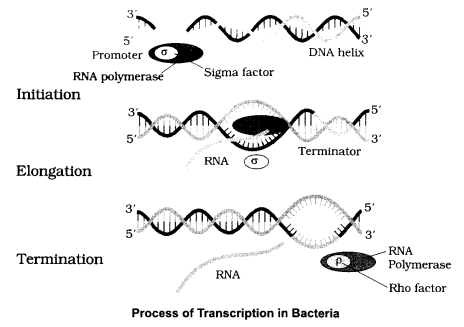
In a bacteria, there are three major types of RNAs: mRNA (messenger RNA), tRNA (transfer RNA), and rRNA (ribosomal RNA). The mRNA provides the template, tRNA brings aminoacids and reads the genetic code, and rRNAs play structural and catalytic role during translation. There is single DNA-dependent RNA polymerase that catalyses transcription of all types of RNA in bacteria. RNA polymerase binds to promoter and initiates transcription (Initiation). It uses nucleoside triphosphates as substrate and polymerises in a template depended fashion following the rule of complementarity. It also facilitates opening of the helix and continues elongation. Only a short stretch of RNA remains bound to the enzyme. Once the polymerases reaches the terminator region, the nascent RNA falls off, so also the RNA polymerase. This results in termination of transcription.
Answer 13.
In barrier methods, ovum and sperms are prevented from physically meeting. Such methods are available for both males and females.
(1) Condoms are made of thin rubber/latex sheath that are used to cover the penis in the male or vagina and cervix in the female, just before coitus so that the ejaculated semen would not enter into the female reproductive tract. This can prevent conception.
(2) Diaphragms, cervical caps and vaults are also barriers made of rubber that are inserted into the female reproductive tract to cover the cervix during coitus. They prevent conception by blocking the entry of sperms through the cervix. They are reusable.
(3) Spermicidal creams, jellies and foams are usually used along with these barriers to increase their contraceptive efficiency.
(4) Intra Uterine Devices (IUDs): These devices are inserted by doctors or expert nurses in the uterus through vagina. These Intra Uterine Devices are presently available as the non- medicated IUDs (e.g., Lippes loop), copper releasing IUDs (CuT, Cu7, Multiload 375) and the hormone releasing IUDs (Progestasert, LNG-20). IUDs increase phagocytosis of sperms within the uterus and the Cu ions released suppress sperm motility and the fertilising capacity of sperms. The hormone releasing IUDs, in addition, make the uterus unsuitable for implantation and the cervix hostile to the sperms.
Answer 14.
Convergent evolution is a evolution of different structures for the same function and hence having similarity. It is the similar habitat that has resulted in selection of similar adaptive features in different groups of organisms but toward the same function.
For example the eye of the octopus and of mammals, the flippers of Penguins and Dolphins, sweet potato (root modification) and potato (stem modification) similarities in proteins and genes performing a given function among diverse organisms give clues to common ancestory.
Answer 15.
The major causes of cancer are:
- Transformation of normal cells into cancerous neoplastic cells which may be induced by physical, chemical or biological agents called carcinogens.
- Ionising radiations like X-rays and gamma rays and non-ionizing radiations like UV cause DNA damage leading to neoplastic transformation.
- The chemical carcinogens present in tobacco smoke have been identified as a major cause of lung cancer.
- Cancer causing viruses called oncogenic viruses have genes called viral oncogenes. Cellular oncogenes (cone) or proto oncogenes have been identified in normal cells which,when activated under certain conditions, could lead to oncogenic transformation of the cells.
Answer 16.
Yes, it is possible to make large quantities of DNA from a single cell by
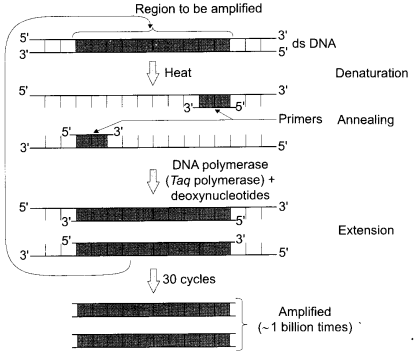
PCR stands for Polymerase Chain Reaction. In this reaction, multiple copies of the gene (or DNA) of interest is synthesised in vitro using two sets of primers (small chemically synthesised oligonucleotides that are complementary to the regions of DNA) and the enzyme DNA polymerase. The enzyme extends the primers using the nucleotides provided in the reaction and the genomic DNA as template. If the process of replication of DNA is repeated many times, the segment of DNA can be amplified to approximately billion times, i.e., 1 billion copies are made. Such repeated amplification is achieved by the use of thermostable DNA polymerase (isolated form a bacterium, Thermus aquaticus), which remain active during the high temperature induced denaturation of double stranded DNA. The amplified fragment if desired can now be used to ligate with a vector for further cloning.
Answer 17.
Advantages of GM plants are:
- GM crops are more tolerant to abiotic stresses (cold, drought, salt, heat).
- These have reduced reliance on chemical pesticides (pest-resistant crops).
- These crops helped to reduce post harvest losses.
- GM crops have increased efficiency of mineral usage which prevents early exhaustion of fertility of soil.
- These crops have enhanced nutritional value of food, e.g., Vitamin ‘A’ enriched rice.
- These crops have also helped in creation of tailor-made plants to supply alternative resources to industries, in the form of starches, fuels and pharmaceuticals.
Answer 18.
Agrobacterium tumifaciens is a pathogen of several dicot plants which has an ability to deliver ‘T-DNA’ that further transforms normal plant cells into a tumor and direct these tumor cells to produce the chemicals required by the pathogen. The tumor inducing (Ti) plasmid of Agrobacterium tumifaciens has now been modified into a cloning vector which is no more pathogenic to the plants but is still able to use the mechanisms to deliver genes of our interest into a variety of plants.
Answer 19.
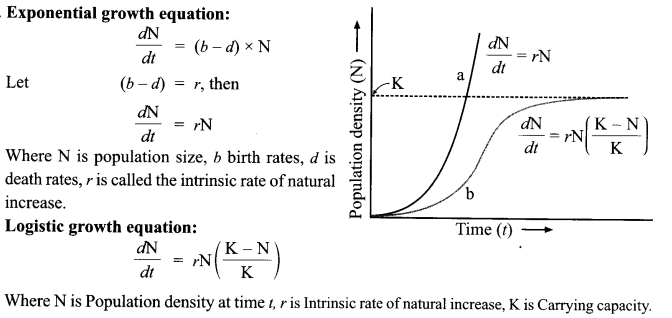
Answer 20.

Answer 21.
Haploid content = 3.3 x 109.
Therefore, diploid content = 6.6 x 109
Distance between bp = 0.34 x 10 9
Therefore length = diploid content x distance between bp
⇒ 6.6 x 109 x 0.34 x 10~9 = 2.24 m
Answer 22.

SECTION-D
Answer 23.
(a) The parents were traditional but understood the need for such advertisements.
(b)

SECTION-E
Answer 24.
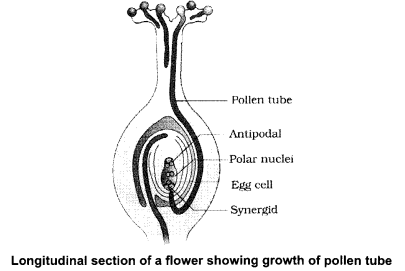
Following compatible pollination, the pollen grain germinates on the stigma to produce a pollen tube through one of the germ pores. The contents of the pollen grain move into the pollen tube. Pollen tube grows through the tissues of the stigma and style and reaches the ovary. In plants, where the pollen grains are shed at the two celled stage, the generative cell divides and forms the two male gametes during the growth of pollen tube in the stigma. In plants which shed pollen in the three-celled condition, pollen tubes carry the two male gametes from the beginning. Pollen tube after reaching the ovary, enters the ovule through the micropyle and then enters one of the synergids through the filiform apparatus. Filiform apparatus present at the micropylar part of the synergids guides the entry of pollen tube. All these events are together referred to as pollen-pistil interaction.
OR
Endosperm development precedes embryo development. The primary endosperm cell divides repeatedly and forms a triploid endosperm tissue. The cells of this tissue are filled with reverse food materials and are used for the nutrition of the developing embryo. In the most common type of endosperm development, the PEN undergoes successive nuclear divisions to give rise to free nuclei. This stage of endosperm development is called free-nuclear endosperm. Subsequently cell wall formation occurs and the endosperm becomes cellular. The number of free nuclei formed before cellularisation varies greatly
Answer 25.
The chromosomal disorders are caused due to absence or excess or abnormal arrangement of one or more chromosomes. Failure of segregation of chromatids during cell division cycle results in the gain or loss of a chromosome), called aneuploidy.
Failure of cytokinesis after telophase stage of cell division results in an increase in a whole set of chromosomes in an organism and is called polyploidy.
Sometimes, either an additional copy of a chromosome may be included in an individual or an individual may lack one of any one pair of chromosomes: These situations are known as trisomy or monosomy of a chromosome, respectively.
Common examples of chromosomal disorders are Down’s syndrome, Turner’s syndrome, Klinefelter’s syndrome.
Down’s Syndrome: Caused by trisomy of 21 chromosome number.
Klinefelter’s Syndrome: Caused due to the presence of an additional copy of X-chromosome resulting into a karyotype of 447, XXY.
Turner’s Syndrome: Caused due to the absence of one of the X chromosome, i.e. 45 with XO.
OR
The salient observations drawn from human genome project are:
- The human genome contains 3164.7 million nucleotide bases.
- The average gene consists of 3000 bases, but sizes vary greatly, with the largest known human gene being dystrophin at 2.4 million bases.
- The total number of genes is estimated at 30,000-much lower than previous estimates of 80,000 to 1,40,000 genes. Almost all (99.9 per cent) nucleotide bases are exactly the same in all people.
- The functions are unknown for over 50 per cent of the discovered genes.
- Less than 2 per cent of the genome codes for proteins.
- Repeated sequences make up very large portion of the human genome.
- Repetitive sequences are stretches of DNA sequences that are repeated many times, sometimes hundred to thousand times. They are thought to have no direct coding functions, but they shed light on chromosome structure, dynamics and evolution.
- Chromosome 1 has most genes (2968), and the Y has the fewest (231).
- Scientists have identified about 1.4 million location where single base DNA differences (SNPs- single nucleotide polymorphism, pronounced as ‘snips’) occur in humans. This information promises to revolutionise the processes of finding chromosomal locations for disease-associated sequences and tracing human history.
Answer 26.
Some interspecific relationship where no species is harmed are:
(1) Commonalism: This is the interaction in which one species benefits and the other is neither harmed nor benefited. For example: an orchid growing as an epiphyte on a mango branch, barnacles growing on the back of a whale, the cattle egret and grazing cattle, and Sea anemones stinging tentacles protect the clown fish from predators that lives among them.
(2) Mutualism: This interaction confers benefits on both interacting species. For example, Lichens represent an intimate mutualjstic relationship between a fungus and photosynthesising algae or cyanobacteria.
(3) Plant-Animal Relationships: Plants need the help of animals for pollinating their flowers and dispersing their seeds; in return plants offer rewards or fees in the form of pollen and nectar for pollinators and juicy and nutritious fruits for seed dispersers.
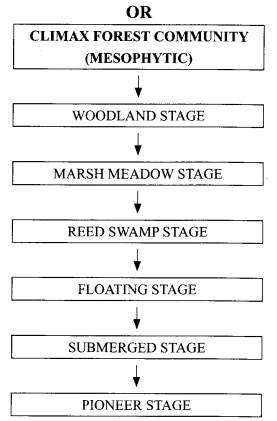
The gradual and fairly predictable change in the species composition of a given area is called Ecological succession. During succession some species colonise an area and their populations become more numerous, whereas populations of other species decline and even disappear. The entire sequence of communities that successively change in a given area are called sere(s). The individual transitional communities are termed serai stages or serai communities. In the successive serai stages there is a change in the diversity of species of organism, increase in the number of species and organisms as well as an increase in the total biomass. Succession is a process that starts where no living organisms are there-these could be areas where no living organisms ever existed, i.e., bare rock; or in areas that somehow, lost all the living organisms that existed there. The former is called primary succession, while the latter is termed secondary succession.
We hope the CBSE Sample Papers for Class 12 Biology Paper 4 help you. If you have any query regarding CBSE Sample Papers for Class 12 Biology Paper 4, drop a comment below and we will get back to you at the earliest.